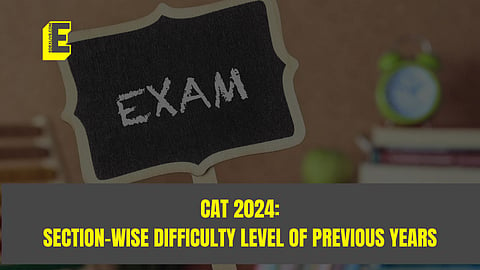

The Common Admission Test (CAT) is around the corner. Let's understand the exam first and its difficulty levels in the past year.
The evaluation scheme was three marks for a correct answer and a penalty of a mark for a wrongly marked multiple-choice question (MCQ), while non-MCQs have no negative marks. This was the same as that of the earlier years.
There were no noticeable surprises as far as the pattern goes as the number of questions per section was the same as that seen in CAT 2022 and 2021.
The overall difficulty of CAT 2023 morning slot was slightly on the higher side compared to all slots of the two previous CATs. The afternoon and evening slots were slightly easier compared to the morning slot.
While the difference in difficulty was not significant, the evening slot had a relatively tougher Quant section.
The VARC section
In the Verbal and Reading Comprehension (VARC) section, while the difficulty of the RC part varied a bit across the three slots, the difference was not much. All the slots had at least two passages that were easy or moderately difficult. However, even the easier passages had difficult questions. The VA part had four question types — Para Formation, Para Odd Man Out, Para Summary and Sentence Placement — with two questions of each question type. This was a slight deviation from the previous years, which had only three question types.
The Quant section
The Quant section across all the slots was significantly tougher than last year’s Quant. Students in the afternoon slot might have braced themselves a bit after having heard feedback from the morning slot candidates. But the evening slot candidates did not have this respite as they still had to deal with a really difficult paper.
Overall, students had to be hands-on with multiple topics as several questions required students to apply concepts across different topics.
The DLIR section
The DILR section this year had the same pattern as last year’s DILR — four sets with five questions each. There was no clear distinction between DI and LR sets this year as there were hardly any sets that were purely LR based. Most sets in each slot involved a fair number of calculations.
A notable feature of the DILR section this year was that there were no sets on graphs or charts. The key to scoring high was selecting the right sets but there were no definitely-easy and must-attempt sets this year.
The Quant section
The Quant section across all the slots was significantly tougher than last year’s Quant. Students in the afternoon slot might have braced themselves a bit after having heard feedback from the morning slot candidates. But the evening slot candidates did not have this respite as they still had to deal with a really difficult paper.
Overall, students had to be hands-on with multiple topics as several questions required students to apply concepts across different topics.
